Comprehensive Financial Accounting: Recording, Analysis, and Reporting
VerifiedAdded on 2023/01/17
|15
|1086
|60
Practical Assignment
AI Summary
This assignment provides a comprehensive solution to a financial accounting problem. It begins with recording business transactions in T-accounts and balancing them. The solution then progresses to preparing a trial balance, an income statement, and a balance sheet. Part B of the assignment delves into ratio analysis, calculating and interpreting key financial ratios for a company ('James') and comparing its performance to industry averages. The analysis covers net profit margin, gross profit margin, current ratio, quick ratio, accounts receivable collection period, and accounts payable payment period. The provided solution includes detailed appendices with the T-accounts, balance sheets, income statements and ratio analysis.

RECORDING BUSINESS
TRANSACTION
TRANSACTION
Paraphrase This Document
Need a fresh take? Get an instant paraphrase of this document with our AI Paraphraser
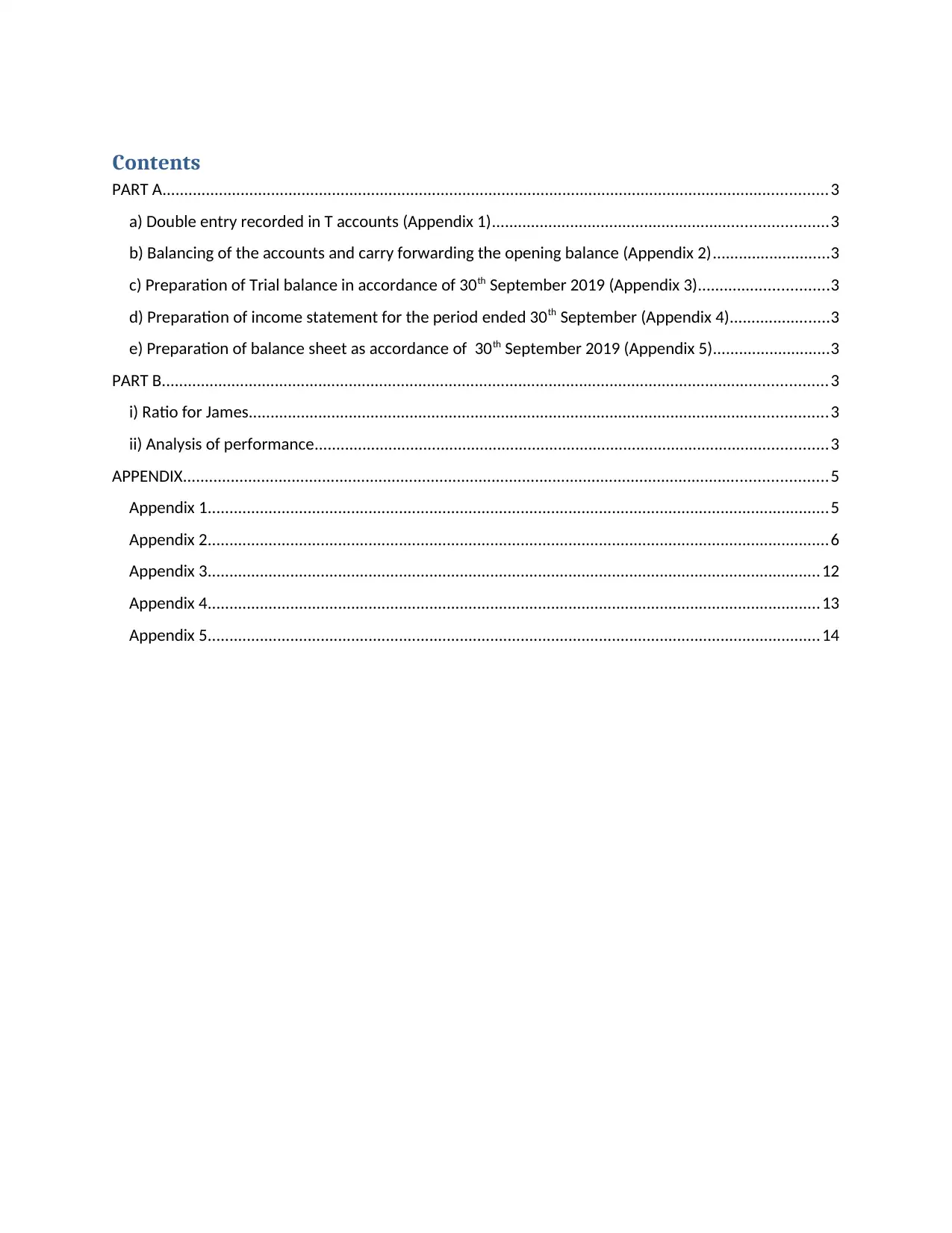
Contents
PART A.........................................................................................................................................................3
a) Double entry recorded in T accounts (Appendix 1).............................................................................3
b) Balancing of the accounts and carry forwarding the opening balance (Appendix 2)...........................3
c) Preparation of Trial balance in accordance of 30th September 2019 (Appendix 3)..............................3
d) Preparation of income statement for the period ended 30th September (Appendix 4).......................3
e) Preparation of balance sheet as accordance of 30th September 2019 (Appendix 5)...........................3
PART B.........................................................................................................................................................3
i) Ratio for James.....................................................................................................................................3
ii) Analysis of performance......................................................................................................................3
APPENDIX....................................................................................................................................................5
Appendix 1...............................................................................................................................................5
Appendix 2...............................................................................................................................................6
Appendix 3.............................................................................................................................................12
Appendix 4.............................................................................................................................................13
Appendix 5.............................................................................................................................................14
PART A.........................................................................................................................................................3
a) Double entry recorded in T accounts (Appendix 1).............................................................................3
b) Balancing of the accounts and carry forwarding the opening balance (Appendix 2)...........................3
c) Preparation of Trial balance in accordance of 30th September 2019 (Appendix 3)..............................3
d) Preparation of income statement for the period ended 30th September (Appendix 4).......................3
e) Preparation of balance sheet as accordance of 30th September 2019 (Appendix 5)...........................3
PART B.........................................................................................................................................................3
i) Ratio for James.....................................................................................................................................3
ii) Analysis of performance......................................................................................................................3
APPENDIX....................................................................................................................................................5
Appendix 1...............................................................................................................................................5
Appendix 2...............................................................................................................................................6
Appendix 3.............................................................................................................................................12
Appendix 4.............................................................................................................................................13
Appendix 5.............................................................................................................................................14

PART A
a) Double entry recorded in T accounts (Appendix 1)
b) Balancing of the accounts and carry forwarding the opening balance (Appendix 2)
c) Preparation of Trial balance in accordance of 30th September 2019 (Appendix 3)
d) Preparation of income statement for the period ended 30th September (Appendix 4)
e) Preparation of balance sheet as accordance of 30th September 2019 (Appendix 5)
PART B
i) Ratio for James
Types of ratios James ratios Competitors' average
Net profit margin 15% 28%
Gross profit margin 60% 65%
Current ratio 16.12X 2.1X
Quick ratio 15.18X 1.5X
Accounts receivable collection period 60.83 or 61 days 47 days
Accounts payable payment period 243 days 65 days
ii) Analysis of performance
On the base of the measured ratios of James plc, it can be seen that there is a wide variation
between that business and its rivals ' results. According to the computed net profit margin ratio, it
can be found that James plc is capable of generating 15% of its operating margin. While its rivals
achieve a net margin of 28 per cent after subtracting all costs. This means that the value of the
business is lower in terms of the net profit margin.
With respect to the gross margin of James plc, this can be determined that their ratio is 60 per
cent, which is 5 per cent lower than that of rivals. The current ratio of James plc is 16.12:1 times
and the rival ratio is 2:1 times. Here's the massive variation that means that James plc must focus
on minimizing its current liabilities so that the current ratio will achieve its ideal form, which is
a) Double entry recorded in T accounts (Appendix 1)
b) Balancing of the accounts and carry forwarding the opening balance (Appendix 2)
c) Preparation of Trial balance in accordance of 30th September 2019 (Appendix 3)
d) Preparation of income statement for the period ended 30th September (Appendix 4)
e) Preparation of balance sheet as accordance of 30th September 2019 (Appendix 5)
PART B
i) Ratio for James
Types of ratios James ratios Competitors' average
Net profit margin 15% 28%
Gross profit margin 60% 65%
Current ratio 16.12X 2.1X
Quick ratio 15.18X 1.5X
Accounts receivable collection period 60.83 or 61 days 47 days
Accounts payable payment period 243 days 65 days
ii) Analysis of performance
On the base of the measured ratios of James plc, it can be seen that there is a wide variation
between that business and its rivals ' results. According to the computed net profit margin ratio, it
can be found that James plc is capable of generating 15% of its operating margin. While its rivals
achieve a net margin of 28 per cent after subtracting all costs. This means that the value of the
business is lower in terms of the net profit margin.
With respect to the gross margin of James plc, this can be determined that their ratio is 60 per
cent, which is 5 per cent lower than that of rivals. The current ratio of James plc is 16.12:1 times
and the rival ratio is 2:1 times. Here's the massive variation that means that James plc must focus
on minimizing its current liabilities so that the current ratio will achieve its ideal form, which is
⊘ This is a preview!⊘
Do you want full access?
Subscribe today to unlock all pages.

Trusted by 1+ million students worldwide
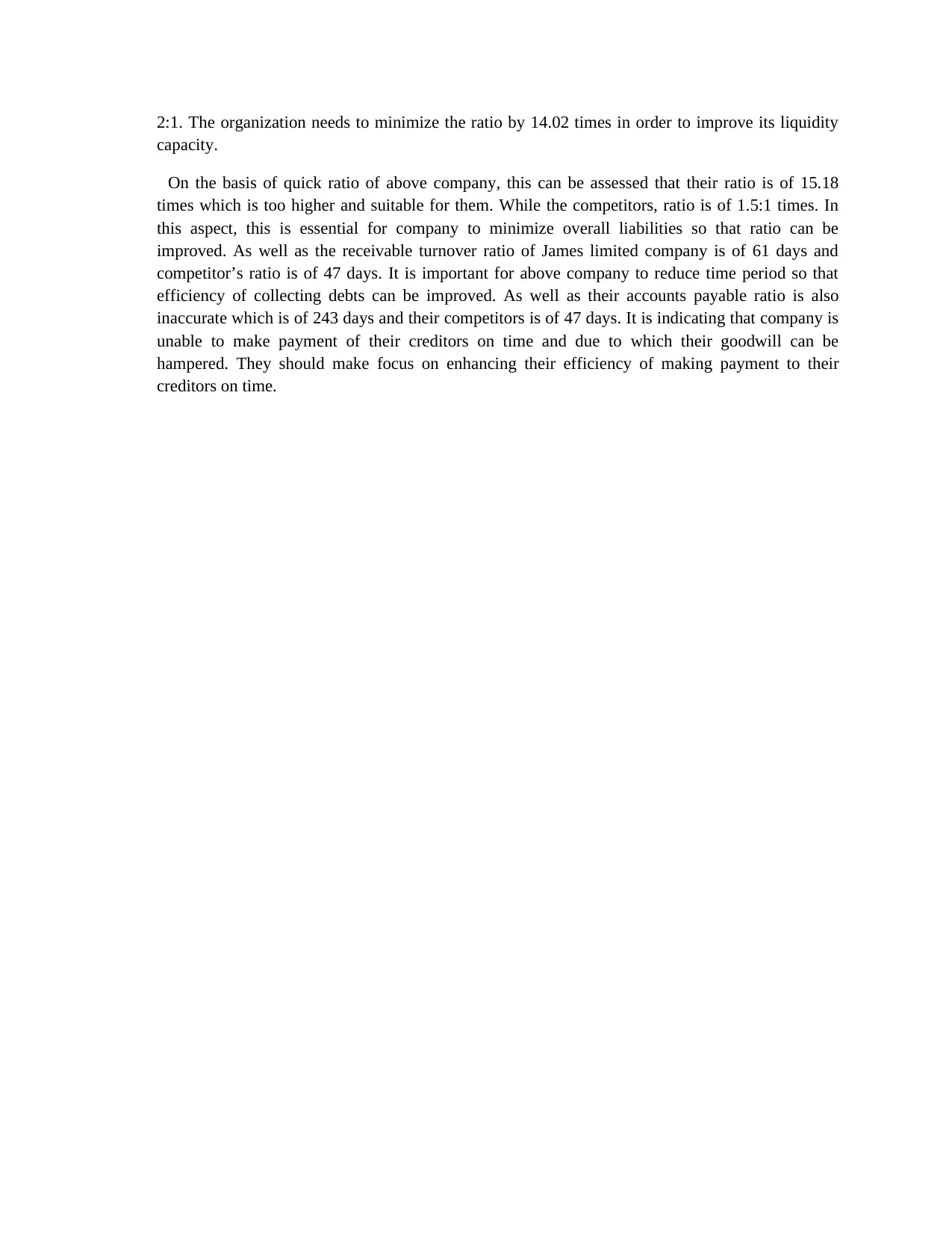
2:1. The organization needs to minimize the ratio by 14.02 times in order to improve its liquidity
capacity.
On the basis of quick ratio of above company, this can be assessed that their ratio is of 15.18
times which is too higher and suitable for them. While the competitors, ratio is of 1.5:1 times. In
this aspect, this is essential for company to minimize overall liabilities so that ratio can be
improved. As well as the receivable turnover ratio of James limited company is of 61 days and
competitor’s ratio is of 47 days. It is important for above company to reduce time period so that
efficiency of collecting debts can be improved. As well as their accounts payable ratio is also
inaccurate which is of 243 days and their competitors is of 47 days. It is indicating that company is
unable to make payment of their creditors on time and due to which their goodwill can be
hampered. They should make focus on enhancing their efficiency of making payment to their
creditors on time.
capacity.
On the basis of quick ratio of above company, this can be assessed that their ratio is of 15.18
times which is too higher and suitable for them. While the competitors, ratio is of 1.5:1 times. In
this aspect, this is essential for company to minimize overall liabilities so that ratio can be
improved. As well as the receivable turnover ratio of James limited company is of 61 days and
competitor’s ratio is of 47 days. It is important for above company to reduce time period so that
efficiency of collecting debts can be improved. As well as their accounts payable ratio is also
inaccurate which is of 243 days and their competitors is of 47 days. It is indicating that company is
unable to make payment of their creditors on time and due to which their goodwill can be
hampered. They should make focus on enhancing their efficiency of making payment to their
creditors on time.
Paraphrase This Document
Need a fresh take? Get an instant paraphrase of this document with our AI Paraphraser
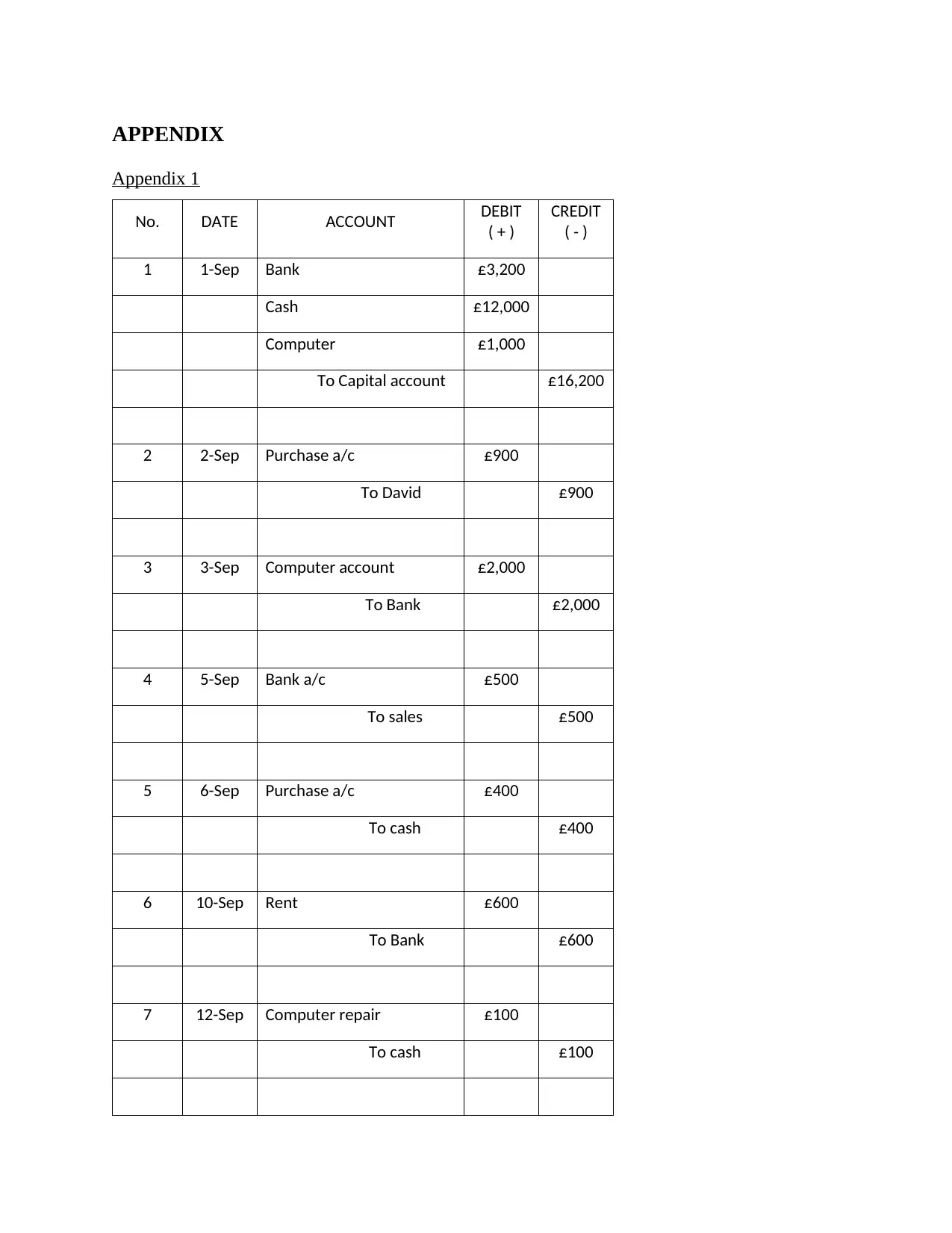
APPENDIX
Appendix 1
No. DATE ACCOUNT DEBIT
( + )
CREDIT
( - )
1 1-Sep Bank £3,200
Cash £12,000
Computer £1,000
To Capital account £16,200
2 2-Sep Purchase a/c £900
To David £900
3 3-Sep Computer account £2,000
To Bank £2,000
4 5-Sep Bank a/c £500
To sales £500
5 6-Sep Purchase a/c £400
To cash £400
6 10-Sep Rent £600
To Bank £600
7 12-Sep Computer repair £100
To cash £100
Appendix 1
No. DATE ACCOUNT DEBIT
( + )
CREDIT
( - )
1 1-Sep Bank £3,200
Cash £12,000
Computer £1,000
To Capital account £16,200
2 2-Sep Purchase a/c £900
To David £900
3 3-Sep Computer account £2,000
To Bank £2,000
4 5-Sep Bank a/c £500
To sales £500
5 6-Sep Purchase a/c £400
To cash £400
6 10-Sep Rent £600
To Bank £600
7 12-Sep Computer repair £100
To cash £100
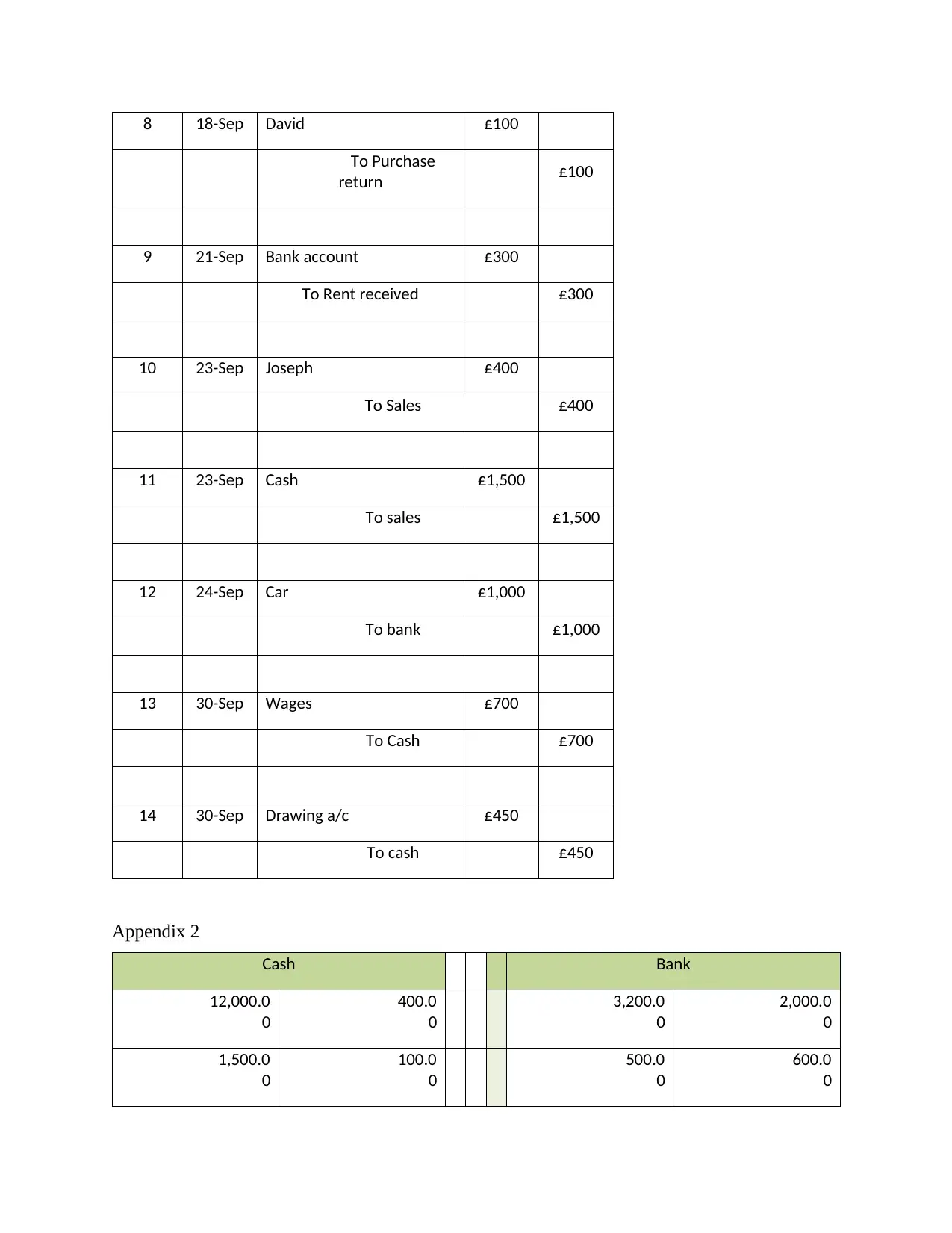
8 18-Sep David £100
To Purchase
return £100
9 21-Sep Bank account £300
To Rent received £300
10 23-Sep Joseph £400
To Sales £400
11 23-Sep Cash £1,500
To sales £1,500
12 24-Sep Car £1,000
To bank £1,000
13 30-Sep Wages £700
To Cash £700
14 30-Sep Drawing a/c £450
To cash £450
Appendix 2
Cash Bank
12,000.0
0
400.0
0
3,200.0
0
2,000.0
0
1,500.0
0
100.0
0
500.0
0
600.0
0
To Purchase
return £100
9 21-Sep Bank account £300
To Rent received £300
10 23-Sep Joseph £400
To Sales £400
11 23-Sep Cash £1,500
To sales £1,500
12 24-Sep Car £1,000
To bank £1,000
13 30-Sep Wages £700
To Cash £700
14 30-Sep Drawing a/c £450
To cash £450
Appendix 2
Cash Bank
12,000.0
0
400.0
0
3,200.0
0
2,000.0
0
1,500.0
0
100.0
0
500.0
0
600.0
0
⊘ This is a preview!⊘
Do you want full access?
Subscribe today to unlock all pages.

Trusted by 1+ million students worldwide
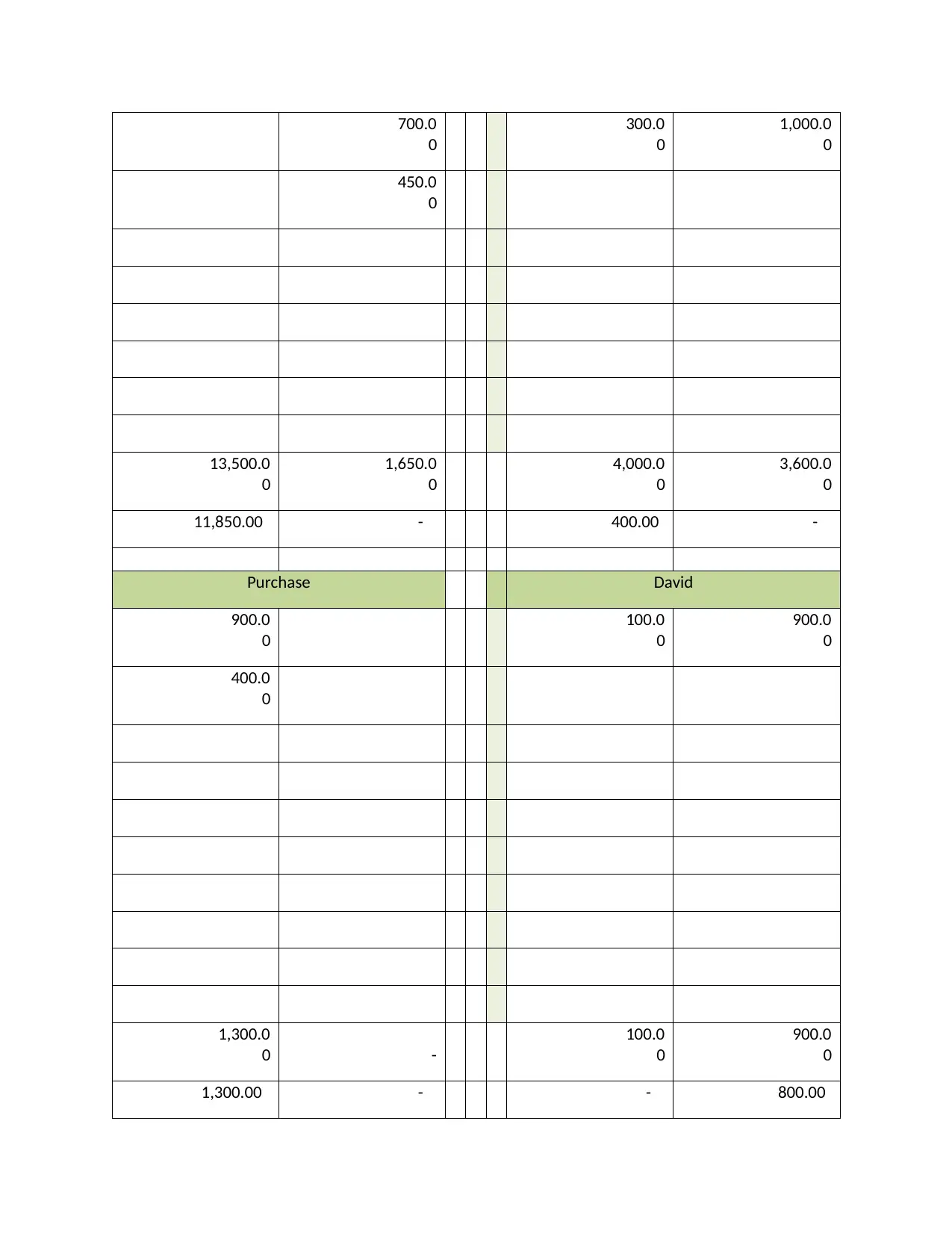
700.0
0
300.0
0
1,000.0
0
450.0
0
13,500.0
0
1,650.0
0
4,000.0
0
3,600.0
0
11,850.00 - 400.00 -
Purchase David
900.0
0
100.0
0
900.0
0
400.0
0
1,300.0
0 -
100.0
0
900.0
0
1,300.00 - - 800.00
0
300.0
0
1,000.0
0
450.0
0
13,500.0
0
1,650.0
0
4,000.0
0
3,600.0
0
11,850.00 - 400.00 -
Purchase David
900.0
0
100.0
0
900.0
0
400.0
0
1,300.0
0 -
100.0
0
900.0
0
1,300.00 - - 800.00
Paraphrase This Document
Need a fresh take? Get an instant paraphrase of this document with our AI Paraphraser
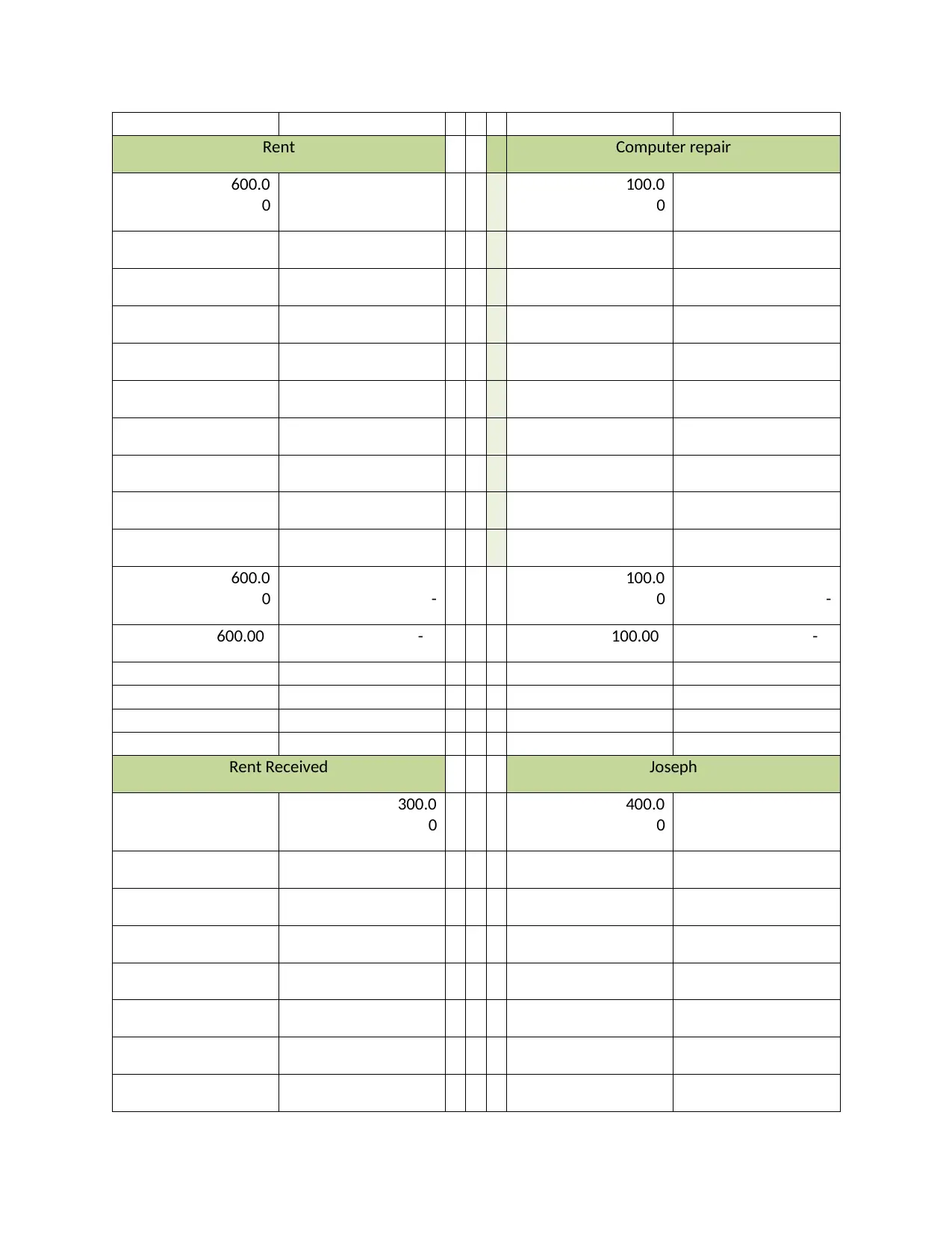
Rent Computer repair
600.0
0
100.0
0
600.0
0 -
100.0
0 -
600.00 - 100.00 -
Rent Received Joseph
300.0
0
400.0
0
600.0
0
100.0
0
600.0
0 -
100.0
0 -
600.00 - 100.00 -
Rent Received Joseph
300.0
0
400.0
0
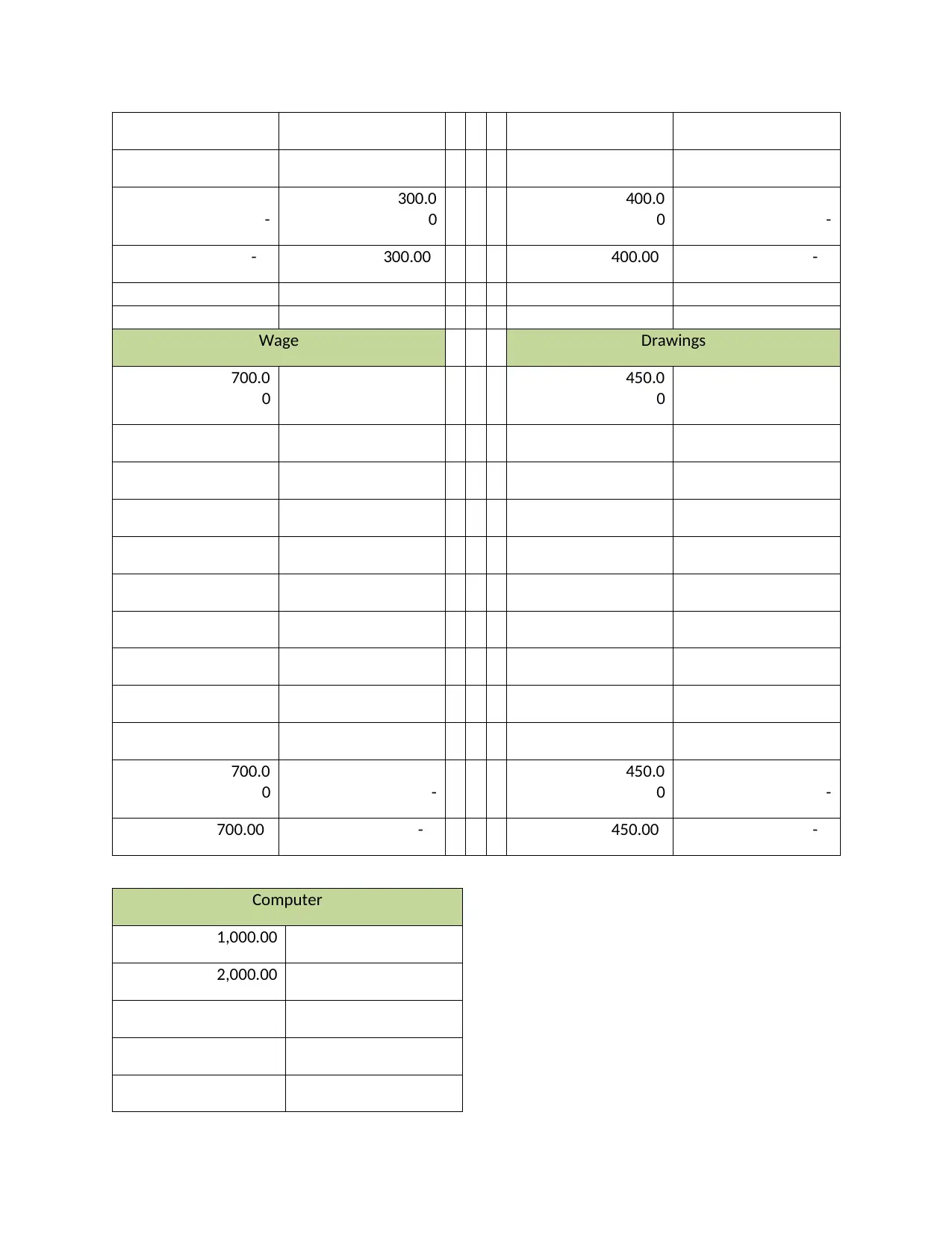
-
300.0
0
400.0
0 -
- 300.00 400.00 -
Wage Drawings
700.0
0
450.0
0
700.0
0 -
450.0
0 -
700.00 - 450.00 -
Computer
1,000.00
2,000.00
300.0
0
400.0
0 -
- 300.00 400.00 -
Wage Drawings
700.0
0
450.0
0
700.0
0 -
450.0
0 -
700.00 - 450.00 -
Computer
1,000.00
2,000.00
⊘ This is a preview!⊘
Do you want full access?
Subscribe today to unlock all pages.

Trusted by 1+ million students worldwide

3,000.00 -
3,000.00 -
Sales
500.00
400.00
1,500.00
- 2,400.00
- 2,400.00
Capital
16,200.00
3,000.00 -
Sales
500.00
400.00
1,500.00
- 2,400.00
- 2,400.00
Capital
16,200.00
Paraphrase This Document
Need a fresh take? Get an instant paraphrase of this document with our AI Paraphraser

- 16,200.00
- 16,200.00
Car
1,000.00
1,000.00 -
1,000.00 -
Purchase return
100.00
- 16,200.00
Car
1,000.00
1,000.00 -
1,000.00 -
Purchase return
100.00

- 100.00
- 100.00
Appendix 3
Trial balance
1 Cash £11,850.00 -
2 bank £400.00 -
3 computer £3,000.00 -
4 Purchase £1,300.00 -
5 David - £800.00
6 Sales - £2,400.00
7 Rent £600.00 -
8 Computer repair £100.00 -
9 Capital - £16,200.00
1
0 Rent received - £300.00
- 100.00
Appendix 3
Trial balance
1 Cash £11,850.00 -
2 bank £400.00 -
3 computer £3,000.00 -
4 Purchase £1,300.00 -
5 David - £800.00
6 Sales - £2,400.00
7 Rent £600.00 -
8 Computer repair £100.00 -
9 Capital - £16,200.00
1
0 Rent received - £300.00
⊘ This is a preview!⊘
Do you want full access?
Subscribe today to unlock all pages.

Trusted by 1+ million students worldwide
1 out of 15
Related Documents
Your All-in-One AI-Powered Toolkit for Academic Success.
+13062052269
info@desklib.com
Available 24*7 on WhatsApp / Email
![[object Object]](/_next/static/media/star-bottom.7253800d.svg)
Unlock your academic potential
Copyright © 2020–2025 A2Z Services. All Rights Reserved. Developed and managed by ZUCOL.




